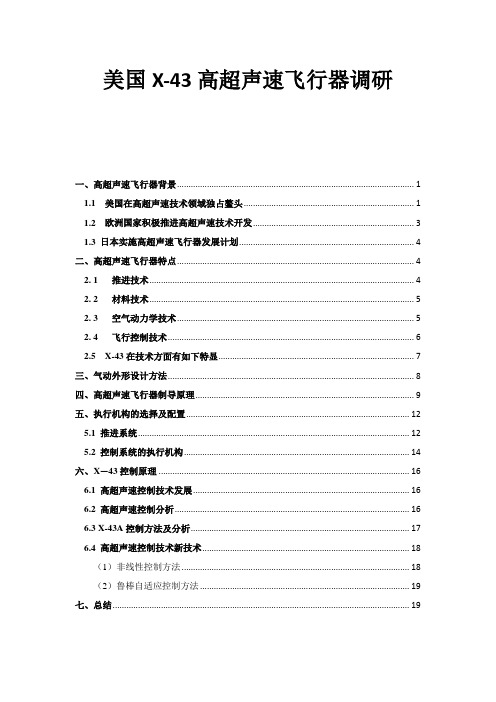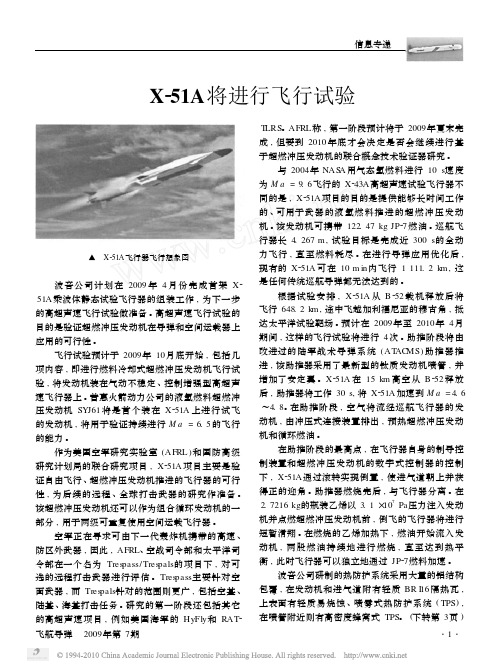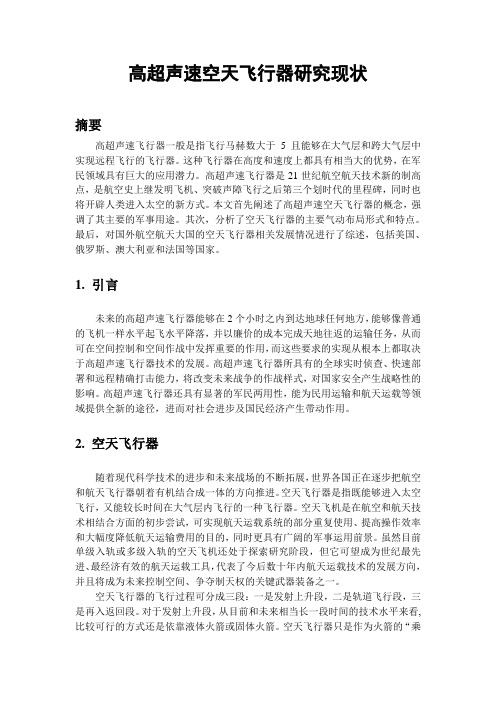X-48B空天飞机飞行研究
四代后战机出现无人机和空天飞机两条技术途径

四代后战机出现无人机和空天飞机两条技术途径来源:新华网2011年元旦一过,有关先进战机的话题一直热度不减。
最初有中国四代机试飞的消息,随后美国人重新启动了未来轰炸机研制项目,2月4日美国的无人战机X-47B实现了首飞。
就在X-47B实现首飞的前一天,美国的《基督教科学箴言报》发表了一篇文章,文章中说俄罗斯暗示将研制类似美国X-37B同类的空天战机。
这些新闻单独来看仅仅是一个个的新闻事件,但是如果把它们综合起来就会发现,围绕着“四代后”未来战机的研制工作已经拉开了帷幕。
美国X-47B无人机首次试飞未来的“四代后”战机什么样?这里说的什么样不是指外貌长得什么样,而是说未来战机的技术途径会是什么样的。
之前的三代机是高机动的,四代机是隐身的、超音速巡航的等,它们各自走了不同的技术途径。
那么“四代后”的未来战机会走什么样的技术途径呢?我们现在能够看到的“四代后”未来战机研发项目有三个,都是来自于美国。
一个是X-37B,它的技术途径是空天战机;一个是美国重启的未来轰炸机项目,关于这个项目的具体内容美国方面透露的很少,但是从目前的情况来分析,它应该是隐身的、具有有人驾驶或无人驾驶两种操纵模式的战略轰炸机;第三个就是X-47B,它是无人驾驶的舰载战斗机(或者说舰载攻击机)。
需要说明的一点是,X-47B可以说是目前世界上研制的第一款无人战斗机(或者说无人攻击机)。
虽然之前无人机也能执行对地攻击任务,而且曾经有过无人机使用机载导弹攻击地面目标并且打死了所谓“基地组织”头目的战例。
但实际上,当时美国使用的无人机(主要指“捕食者”)和X-47B是完全不同的概念。
“捕食者”是以侦察任务为主,它仅仅是挂载了导弹,执行攻击任务是它执行侦察任务之后的一个辅助性的功能;而X-47B是以对地攻击为主要任务的,所以我们说它是世界上第一款“无人战斗机”(或者说无人攻击机)。
从以上三个型号的技术定义角度来看,它们走了两条不同的技术道路:一条是无人机的技术道路,不管是X-47B还是未来轰炸机,甚至是X-37B都采用无人驾驶这种模式或者完全是无人驾驶的飞行器;另一条是空天飞机的技术途径,X-37B走的就是典型的这种技术道路。
X-51A超燃冲压发动机及飞行验证计划

Ke r s ca jt n ie y esnc ri is e yWo d :S rm e gn :H p ro i;C us m si e e l
0 前
言
表示 是 x.l飞行器 系列 中的第 1个 飞行器 的设计 方 5 案。
国家空天 飞机计划 ( NAS ) 2 P 在 0世纪 9 0年代 中
Ze g Hui Ba n h n, Zhu Ta n , iHa c e t
( hn r d n mi sac C iaAeo y a cRee rh& De eo me t ne , M in a g, 6 2 6 ) v lp n tr Ce ay n 2 6 3
A s at h tn A rF reR sac a oao ( F L/ fneA vn e eerhPoet A ec ( R A) 5A b t c:T e it i oc ee hL b rtr A R ) es d a cd R sac r c g ny DA P X一1 r j r y De j s
图 1 X 5 A 的研究机构 一1
X 5A 计划由多家政府机构和商业公司共同参与 .1
( 图 1 。 AR A 的战术技 术办 公室 ( T 提 供辅 见 )D P T 0) 助 的 管 理 和 技 术 支 持 , 并 为 项 目提 供 部 分 资 助 。 D P 和 空 军 为 项 目提 供 24 亿 美 元 的 资金 ,在 AR A . 6 20  ̄2 1 0 3 0 0年分 配使用 。
S rm e E gn mos ao- ae ie (E v hc efg t e nt t no F L S p r ncT cn lg H T c ) ca jt n ieDe nt tr v Rd r S D) eil i t l h mo s a o f R ’ Hy es i eh oo y( y eh r W e sh i d ri A o
从X_47B看美国无人作战飞机发展_沈林成

一、引言无人作战飞机(Unmanned Combat Air Vehi -cle ,UCAV )具备高隐身、高机动、高智能、低成本等优势,可以代替有人机或者与有人机协同执行对敌防空系统压制(Suppression of Enemy Air De -fense ,SEAD )、纵深攻击以及对空作战等任务,是未来航空武器装备的重要组成部分,代表未来空中作战力量无人化的发展趋势。
从广义上讲,无人作战飞机按照作战任务可以分为三类[1]:一是情报、监视与侦察(Intelligence,Surveillance,and Reconnaissance ),ISR 无人机。
如美军“捕食者”、“死神”无人机,此类无人作战飞机首先用于情报、监视与侦察任务,在必要时可以提供火力打击。
二是大型、先进的隐身无人作战飞机,如美国海军X-47B 和空军X-45C 、法国神经元、英国雷神等,此类无人作战飞机是一种可以突破敌防空系统并实施纵深攻击的高度复杂武器系统。
三是小型、敏捷、可消耗无人作战飞机,类似大型远程巡航导弹,可以重复使用。
如洛克希德·马丁的“Minion ”概念,但目前处于概念研究阶段。
目前无人作战飞机主要是特指第二类无人作战飞机。
无人作战飞机是无人机系统发展过程中的一个重大里程碑,将对未来的军事作战方式产生深远的乃至革命性的影响。
它的出现标志着无人机系统将从过去作为执行侦察监视、通信中继和毁伤评估等任务的作战支援装备,升级为未来能够对陆/海/空重要目标实施精确打击的主战装备之一。
近年来,国外军事强国对无人作战飞机系统的发展尤其重视[2]。
其中,美国在无人机系统发展上一直走在全球最前列,无人机种类繁多,技术也最为先进。
无人机系统已在美军的历次局部战争中发挥了重要的作用。
而且,美军的无人作战飞机发展也最快,已经完成了无人作战飞机作战概念仿真和航母起降飞行试验,下一步即将开展自主空中加油和多机协同任务作战的演示验证。
美X-51A飞行器首次飞行试验成功

综合 作战效 能可 达 0 6也 就是 说 , 。; 它可 以使 对 方雷 达
的搜 索发现 概率 或探测 目标距 离下 降 5 ~6 。 0 O
b 当干扰对象主 )
踪雷达 火控雷达时
4 结束 语
一 … 一
K =1一尺z R . 2 r / =0 4
此 时 , 干=KJ E PM=0 9 . 2 . 0 . 5 0 4 =0 4 X
6 0
航 天 电 子 对 抗
2 1 () 0 0 4
a 当 干扰 对象 主要是搜 索 、 ) 警戒雷 达时 , 干信 比 设
搜索、 警戒 雷 达综 合作 战效 能 可达 0 5 , . 6 对火 控雷 达
为为 3 通过近 似计算 可得 ,
KJ 一P p =1 / 出=0 3 , . 6 此时 , 干:KJ M:0 3 E P .4
本 文 以解 析方法 为 基 础 , 充分 考 虑 电子 战 的 战斗
3 电子干扰 吊舱综 合作 战效能 E )
电子 干扰 吊舱 的 综合 作 战效 能 E和 电子 干 扰 吊 舱 的侦察效 能及 干扰效 能有关 , 其权数 6 为 0 4 n / 取 . ,
取 为 06 则 : ・, a 当干扰对象 主要是 敌搜 索 、 戒雷达 时 ) 警 E 0 4 侦十0 6 千 0 3 ・E ・ E ・ 6+0 2 0 5 ・0 ・6
2o 08
.
b 当干扰对 象 主要是跟踪 雷达 , ) 即火 控雷达 时
E 0 4 侦 + 0 6E= 0. 6+ 0. 4 0. 0 .E . r 3 2 6
[] 刘永红. 2 电子对抗 系统作战效能模型及其应用U- 电 子 I
.
对抗技术 2 0 1 () 0 2, 7 5 .
以综合学术角度剖析美国X-43A超高声速飞机的试验

美国政府耗费巨资支持的造假—超高速飞机的神话柝解以综合学术角度剖析美国X-43A超高声速飞机试验作者深圳刘昌喆注:本文是应《中国军事》杂志建军八十周年记念约稿而作(2007)。
因观点非主流而被拒载。
留此存照,亦期交流。
2008年上传此文,因博客字数所限分成上下两部分,阅读不方便。
如今网站进步又重新整篇上传,—2010年的说明。
又注:当年文档中插不进图片,如今网站功能强大,所以加进图片整理重发。
美国的超高速骗局还在继续重演,2012年又有X-51试飞报道。
所以这篇写于2007年的文章仍有现实参考意义。
关键词:超高音速激波燃烧速度混合过程动量结构空气动力学飞行姿态稳定性学术结果不真实摘要:美国超高音速飞机X-43A在2001年曾试飞失败,当时舆论界在将信将疑中毁誉参半。
在2004年发布的X-43A飞机两次试验成功的结果以后,全世界舆论都为之贺彩;美国舆论称之为莱氏兄发明飞机后又一航空史上的重大突破。
各国航空学界多为美国科技之高超而折服,进而引发一轮包括中国在内的全世界范围的超高音速冲压发动机研发跟风热潮。
本文以严谨的多学科理论根据分析,证明该耗资1.8亿美金、轰动世界的试验原理上就存在多方面致命错误。
而关于所谓“试验的成功”的各种报道,也破绽多多,经不起推敲。
事实并非如报道的那样辉煌。
这应该是在美国政府出于政治利益而默许的、研究单位出于对耗掉如此巨资而无果,因利益需要的一起毫门学术造假。
一、X-43A超高音速飞机的“试验飞行”成功报道中的疑点X-43A超高音速飞机的“试验飞行”成功,在网上、报刊和电视的所有新闻媒体都有一段时间醒目的报道。
但在所有关于X-43A报道却有着共同的疑点:1、为什么耗此1.8亿巨资的,又是“成功”的试验项目最有价值的试验飞机不回收?这在技术上和经济上都应没有障碍(现代技术人造卫星都可以收回),尤其X-43A是在海面溅落,回收相对更容易。
如回收飞机实体,一是有助技术总结的巨大科研价值,二是可与莱氏兄弟的飞机同样陈列在美国国家博物馆,其里程碑式“成功”使该试验飞机文物价值应该无法估量。
X-47B改变现代战争模式

军情关注12/ 军事文摘/ 2013.07X-47B,走你!5月14日,美国海军在“乔治·布什”号航母上首次进行了X-47B隐形无人攻击机的弹射起飞试验,这表明X-47B向形成实战能力又迈出一大步。
X-47B的研制成功,表明美国海军将拥有更强大的对地打击能力,美军的全球干涉能力和灵活性也得到提高。
不过隐身无人机的运用依然受到许多限制,人类还没有真正迈入无人作战飞机大规模应用的门槛。
1990年,美国入侵巴拿马,首次动用F-117A隐身攻击机,此后历次局部战争,隐身飞机都是美军突袭行动的急先锋,摧毁了对方大量的战略与战术目标,堪称美军的“雷神之槌”,为对方造成了巨大的军事压力,除了南联盟击落过一架F-117A之外,美军隐身作战飞机基本上全身而退,显现了巨大的效费比。
隐身飞机是美军作战能力的基石不过美军的隐身作战飞机如F-22、F-117A、B-2都隶属于空军,美国海军曾经计划研制A-12隐身攻击机、NATF隐身作战飞机,但由于冷战后美国债台高筑,军费压力太大,不得不放弃计划,曾经被寄以厚望的F-35又一拖再拖,因此,美国海军至今都没有属于自己的隐身飞机,这样,美军全球作战的重任就全部压在了空军身上,造成其隐身作战飞机负担过重,特别是F-117A攻击机退役后,美国空军隐身作战飞机只有F-22和B-2两种,并且屋漏又逢连夜雨,F-22因制氧系统故障,影响了其战斗力的生成和发挥,对其进行空中作战造成了较大的压力。
21世纪,美国海军的航母是美军前沿存在的主要力量。
在海湾战争中,美国海军的航母编队迅速抵达战区,形成威慑,但是它却缺乏隐身打击能力,这种局面直到F-35上舰以后才能得到缓解。
不过F-35本身负担较多的空中优势任务,如果再执行对地打击任务,部队的调配可能会出现问题。
鉴于此,美军全球干涉任务可能越来越多地倚重于B-2隐身轰炸机,从而导致B-2在频繁的作战与训练任务中,快速地消耗自己的寿命,美军的全球作战能力因此而大打折扣。
美国X系列试验飞行器简史

美国X系列试验飞行器简史X-1X-1 试验飞机作为人类历史上一种划时代的飞机,不仅仅是因为它的速度超过了音速,也是因为它是世界上第一种纯粹为了试验目的而设计制造的飞机。
X-1 最初设想来自于 20 世纪 30 年代末飞机设计领域所遇到的问题,当时建造的风洞已经不能满足飞机在亚音速和超音速飞行条件下各种参数的正确搜集,因而研制一种专用的飞行试验机势在必行。
贝尔飞机公司制造的 3 架 X-1 机长 9.45 米,机高 3.35 米,翼展 8.53 米,其机身形状与 12.7 毫米机枪子弹极其相似,这样可在超音速飞行时保持机体的稳定。
X-1 的机翼为平直翼,翼面厚度很小。
XLR-11 火箭发动机为其提供动力,其燃料为液氧与酒精和水的混合物。
X-1-1、X-1-2 于 1945 年相继出厂开始了试验飞行,与此同时 NACA(美国国家航空咨询委员会,美国国家航空航天局 NASA 的前身)也加入了 X-1 项目的研制工作。
X-1 试验机和 B-29 载机超音速飞行中的 X-11947 年 10 月 14 日,试飞员查理斯.耶格尔驾驶 X-1-1 在 43,00 英尺的高空飞出了 1.06 马赫的高速,从而迈出了人类超音速飞行的第一步。
不久,X-1-2 在飞行试验中速度也超过了音速。
1950 年 5 月 12 日,X-1-1 在耶格尔的驾驶下完成了最后一次试验光荣退休了。
随后,X-1-2 也停止了飞行开始进行改造。
NACA 的工程师们为 X-1-2 设计了新的机翼和新型的涡轮泵燃油系统,另外还将试飞员从侧面舱门进入驾驶舱的设计改为向上开启的座舱盖,这样 X-1-2 就成为了 X-1E。
X-1E 是用来验证薄翼气动特性的,它是第一架采用 4% 机翼厚度飞行成功的飞机。
另外还有必要提一下 X-1-3,由于其燃料供给系统进行了改进,所以其理论最高速度可以达到 2.4 马赫,远远超过了前两者。
但这架 X-1-3 运气不太好,在一次试飞中由于燃料泄漏事故和载机 B-50 一起在空中炸成了碎片。
美国X_47B无人战斗机的反导可行性及优势分析

NCADE 比 现 有 全 重 152 kg 的 AIM-120 还要轻 12 kg,单从载荷 质量 上 看,X-47B 可 以 携 带 13 枚以上 NCADE 拦截弹,这是目 前任何导弹防御系统都难以达到 的能力。当然由于 NCADE 射程 限制,目 前 其 还 只 能 对 最 近 约 150 km,最远约 350 km 范围内 发射 的 导 弹 进 行 拦 截。而 随 着 NCADE 的改 进,一 旦 速 度 达 到 5 km / s以上,即可满足 1 050 km 拦截距离的要求。 1. 3 飞机部署可行性
从上 面 分 析 可 以 看 出,X47B 携带的拦截弹的飞行速度对 其完成拦截至关重要。目前,美 国地基中段拦 截 弹、THAAD 和 标 准-3IA 的 关 机 速 度 分 别 为 5. 6 km / s、2. 7 km / s 和 5 km / s。 而美国目前发展的空基拦截弹网 络中 心 机 载 防 御 单 元 ( NetworkCentric Airborne Defense Element, NCADE) 采用了 AIM-120 的总体 设计,其可以在高于20 km 的高 度上拦截处于 20 km ~ 80 km 高 空中的弹道导弹,作战半径达到 25 km ~ 150 km,拦截弹速度达 到了 2. 5 km / s,其可以超声速飞 行 20 s ~ 60 s。此外,雷锡恩公 司还计划将单级火箭的 AIM-120 改装为了两级 NCADE 系统,第 飞航导弹 2011 年第 11 期
图 1 2011 年 2 月进行飞行试验的 X-47B
X-47B 具 有 超 长 滞 空 时 间,据 称,其滞空时间可能长达 50 h, 而且还可以进行空中加油,作战 半 径 可 达 2 800 km; 其 次, X47B 具有较大的载弹量,其载弹 量 与 F-117 基 本 相 同, 达 2 000 kg, 可 携 带 两 枚 质 量 900 kg 联 合 直 接 攻 击 弹 药; 此 外,它不但飞行高度达 12. 2 km ( B-2A 为 15. 24 km, F-117 为 10. 67 km) ,而且还具有隐身功 能。另 外,其 飞 行 速 度 接 近 声 速,这是其它无人平台无可比拟 的。这些优异的性能都为其成为 海军反导武器平台奠定了基础。
美军又在研究超高音速飞行器

美军又在研究超高音速飞行器据美国军事官员称,美国空军正在与军队的国防高级研究计划局(DARPA)合作一个新的项目——测试超高音速飞行能力。
实验方案正在最后定稿的过程中,旨在促进对超高音速飞行的研究,包括从开始于2004年的空军价值3亿美元的X-51A Waverider 的方案中获取信息。
无人驾驶机X-51A在5月1日成功完成了该计划的最后飞行,在计划好的紧急迫降前6分钟内,X-51A达到了最高速度5.1马赫(音速的5倍多),行驶了230多海里英里(425公里)。
空军官员当时说,这种超高音速飞行器飞行试验时间是有史以来最长的。
根据空军首席科学家Mica Endsley说。
五月份飞行测试实验使用的是波音公司最新的X-51A飞行器,目前没有再造飞行器的计划,但美国空军和DARPA合作的新方案将会建立在X-51A设计的基础上,将仔细寻找使超高音速技术更易于操作的方法。
“我们的X-51飞行非常成功,它展现了超高音速飞行器的速度。
” Endsley告诉Military网站,“我们现在正和DARPA合作一个后续的合资谅解备忘录的方案。
”美国军方官员说超高音速技术可以用来开发新的武器,飞机能够在很短的时间内到达地球上任何地方,超高音速飞行通常能达到任何5马赫以上的速度。
在海平面上,声音的速度是大约763英里(1,226公里/小时)。
5月1日,连接在一架B-52H“同温层堡垒”机翼的底面的X-51A从位于加利福尼亚州的爱德华兹空军基地起飞,在大约50,000英尺(15,000米)释放助推器,并在仅仅26秒内采用固体火箭助推器加速到4.8马赫。
在60,000英尺(18,300米)的高空时,X-51A与火箭分离,并靠超音速燃烧冲压式喷气发动机达到5.1马赫。
DARPA还用该机构的自身HTV高超音速轰炸机进行了高超声速飞行试验。
在2011年8月,HTV 滑翔机最高速度达到20马赫,不过随后失去控制。
美国X-43高超声速飞行器调研

美国X-43高超声速飞行器调研一、高超声速飞行器背景 (1)1.1美国在高超声速技术领域独占鳌头 (1)1.2 欧洲国家积极推进高超声速技术开发 (3)1.3 日本实施高超声速飞行器发展计划 (4)二、高超声速飞行器特点 (4)2. 1 推进技术 (4)2. 2 材料技术 (5)2. 3 空气动力学技术 (5)2. 4 飞行控制技术 (6)2.5 X-43在技术方面有如下特显 (7)三、气动外形设计方法 (8)四、高超声速飞行器制导原理 (9)五、执行机构的选择及配置 (12)5.1 推进系统 (12)5.2 控制系统的执行机构 (14)六、X—43控制原理 (16)6.1 高超声速控制技术发展 (16)6.2 高超声速控制分析 (16)6.3 X-43A控制方法及分析 (17)6.4 高超声速控制技术新技术 (18)(1)非线性控制方法 (18)(2)鲁棒自适应控制方法 (19)七、总结 (19)一、高超声速飞行器背景高超声速飞行器是指在大气层内飞行速度达到M a = 5以上的飞行器。
自20世纪60年代以来, 以火箭为动力的高超声速技术已广泛应用于各类导弹和空间飞行器, 而目前世界各国正在积极发展另一类以吸气式发动机为动力的高超声速飞行器技术, 它的航程更远、结构质量轻、性能更优越。
实际上, 吸气式高超声速技术的发展始于20世纪50 年代,通过几十年的发展, 美国、俄罗斯、法国、德国、日本、印度、澳大利亚等国自20世纪90年代以来已在高超声速技术方面陆续取得了重大进展, 并相继进行了地面试验和飞行试验。
高超声速技术实际上已经从概念和原理探索阶段进入了以高超声速巡航导弹、高超声速飞机和空天飞机等为应用背景的先期技术开发阶段。
1.1美国在高超声速技术领域独占鳌头从1985 年至1994 年的10年间, 美国国家空天飞机计划(NASP)大大推动了高超声速技术的发展。
通过试验设备的大规模改造和一系列试验, 仅美国NASA 兰利研究中心就进行了包括乘波体和超燃发动机试验在内的近3 200次试验。
X_51A将进行飞行试验

X 251A将进行飞行试验▲ X 251A 飞行器飞行想象图 波音公司计划在2009年4月份完成首架X 251A 乘波体静态试验飞行器的组装工作,为下一步的高超声速飞行试验做准备。
高超声速飞行试验的目的是验证超燃冲压发动机在导弹和空间运载器上应用的可行性。
飞行试验预计于2009年10月底开始,包括几项内容,即进行燃料冷却式超燃冲压发动机飞行试验,将发动机装在气动不稳定、控制增强型高超声速飞行器上。
普惠火箭动力公司的液氢燃料超燃冲压发动机SYJ61将是首个装在X 251A 上进行试飞的发动机,将用于验证持续进行M a =6.5的飞行的能力。
作为美国空军研究实验室(AFRL )和国防高级研究计划局的联合研究项目,X 251A 项目主要是验证自由飞行、超燃冲压发动机推进的飞行器的可行性,为后续的远程、全球打击武器的研究作准备。
该超燃冲压发动机还可以作为组合循环发动机的一部分,用于两级可重复使用空间运载飞行器。
空军正在寻求可由下一代轰炸机携带的高速、防区外武器,因此,AFRL 、空战司令部和太平洋司令部在一个名为Tres pass/Tres pals 的项目下,对可选的远程打击武器进行评估。
Tres pass 主要针对空面武器,而Tres pals 针对的范围则更广,包括空基、陆基、海基打击任务。
研究的第一阶段还包括其它的高超声速项目,例如美国海军的HyFly 和RAT 2T LRS 。
AFRL 称,第一阶段预计将于2009年夏末完成,但要到2010年底才会决定是否会继续进行基于超燃冲压发动机的联合概念技术验证器研究。
与2004年NAS A 用气态氢燃料进行10s 速度为M a =9.6飞行的X 243A 高超声速试验飞行器不同的是,X 251A 项目的目的是提供能够长时间工作的、可用于武器的液氢燃料推进的超燃冲压发动机。
该发动机可携带122.47kg JP 27燃油。
巡航飞行器长4.267m ,试验目标是完成近300s 的全动力飞行,直至燃料耗尽。
高超声速空天飞行器研究现状汇总

高超声速空天飞行器研究现状摘要高超声速飞行器一般是指飞行马赫数大于5且能够在大气层和跨大气层中实现远程飞行的飞行器。
这种飞行器在高度和速度上都具有相当大的优势,在军民领域具有巨大的应用潜力。
高超声速飞行器是21世纪航空航天技术新的制高点,是航空史上继发明飞机、突破声障飞行之后第三个划时代的里程碑,同时也将开辟人类进入太空的新方式。
本文首先阐述了高超声速空天飞行器的概念,强调了其主要的军事用途。
其次,分析了空天飞行器的主要气动布局形式和特点。
最后,对国外航空航天大国的空天飞行器相关发展情况进行了综述,包括美国、俄罗斯、澳大利亚和法国等国家。
1. 引言未来的高超声速飞行器能够在2个小时之内到达地球任何地方,能够像普通的飞机一样水平起飞水平降落,并以廉价的成本完成天地往返的运输任务,从而可在空间控制和空间作战中发挥重要的作用,而这些要求的实现从根本上都取决于高超声速飞行器技术的发展。
高超声速飞行器所具有的全球实时侦查、快速部署和远程精确打击能力,将改变未来战争的作战样式,对国家安全产生战略性的影响。
高超声速飞行器还具有显著的军民两用性,能为民用运输和航天运载等领域提供全新的途径,进而对社会进步及国民经济产生带动作用。
2. 空天飞行器随着现代科学技术的进步和未来战场的不断拓展,世界各国正在逐步把航空和航天飞行器朝着有机结合成一体的方向推进。
空天飞行器是指既能够进入太空飞行,又能较长时间在大气层内飞行的一种飞行器。
空天飞机是在航空和航天技术相结合方面的初步尝试,可实现航天运载系统的部分重复使用、提高操作效率和大幅度降低航天运输费用的目的,同时更具有广阔的军事运用前景。
虽然目前单级入轨或多级入轨的空天飞机还处于探索研究阶段,但它可望成为世纪最先进、最经济有效的航天运载工具,代表了今后数十年内航天运载技术的发展方向,并且将成为未来控制空间、争夺制天权的关键武器装备之一。
空天飞行器的飞行过程可分成三段:一是发射上升段,二是轨道飞行段,三是再入返回段。
走近神秘的X-47B舰载无人机

作者: 高斯佳
作者机构: 不详
出版物刊名: 国防科技工业
页码: 64-65页
年卷期: 2011年 第3期
主题词: 舰载无人机 《华尔街日报》 美国海军 加利福尼亚 空军基地 爱德华兹 飞行试验技术发展
摘要:2011年2月初,由诺斯罗普·格鲁曼公司研发的X-47B舰载无人机,从位于美国加利福尼亚的爱德华兹空军基地悄然起飞,成功进行了首次飞行试验。
美国《海军时报》报道称,X-47B首飞,成为美国海军在开发舰载无人机过程当中的一个里程碑。
《华尔街日报》也表示,该型机被视为无人机技术发展的一个重大突破。
那么X-47B到底是一款什么样的飞机,性能如何,未来又有怎样的发展前景,让我们一起走近X-47B,揭开它的神秘面纱。
X-48B无人翼身融合体(BWB)验证机成功首飞

X-48B无人翼身融合体(BWB)验证机成功首飞
佚名
【期刊名称】《电子对抗》
【年(卷),期】2007(000)004
【摘要】X-48B无人翼身融合体(BWB)验证机于7月20日在NASA位于加利福尼亚州爱德华兹空军基地内的德莱顿飞行研究中心进行了首次飞行试验,试验的目的是收集稳定性和飞行控制特性方面的细节信息,特别是在飞行器起飞和着陆过程中。
【总页数】1页(P5)
【正文语种】中文
【中图分类】V221.3
【相关文献】
1.EADS公司未来无人作战飞机验证机实现首飞 [J], 佚名
2.京东自研"京蜓"自转旋翼无人机首飞成功 [J],
3.“幻影线”无人演示验证机顺利完成首飞 [J], 周小坤
4.EADS公司的“梭鱼”(Barracuda)无人验证机首飞 [J],
5.美国海军X-47B无人空战系统验证机首飞推迟 [J],
因版权原因,仅展示原文概要,查看原文内容请购买。
美国X系列验证机

美国X系列验证机美国X系列验证机1. X-30X-30 是由美国国防部和NASA 共同组织研制的一种双座高超音速研究机,同时也是由DARPA 提出的国家空天飞机(NASP)计划的原型机。
X-30 实际上是一种能水平起降单级入轨、高超音速的航天飞机,采用尖头狭身机体大后掠三角翼单垂尾布局,以减少高速飞行时的阻力。
X-30 的机身从前到后为头锥、两人驾驶舱、电子设备舱、燃料舱,在机体腹部的动力装置由涡轮冲压/超音速燃烧冲压/入轨和再入大气火箭发动机构成,机体主要使用钛基复合材料,表面高热部分用带有内部冷却系统的防热材料敷设。
由于其研制难度太大和研制费用过高,X-30 项目仅仅只是停留在缩比模型研究阶段,并在1994 年11 月被取消,因而没有建造任何全尺寸实体样机。
X-30 的想象图2. X-33X-33 由洛克希德.马丁公司著名的“臭鼬工程队”研制,它是无人驾驶单级入轨可重复使用航天运载飞行器“冒险星”的1/2 比例的原型机,机长20.29 米,机高 5.88 米,翼展22.06 米。
X-33 采用垂直起飞方式,亚轨道飞行,能在飞行跑道上着陆。
X-33的动力采用一台波音公司特别开发的J2S 火箭发动机,其余部件也是包含了诸多高科技元素。
2001 年 3 月,同样由于存在诸多难以突破的技术难关(如线性气塞式发动机),NASA 取消了已经耗资了13 亿美元的X-33 项目。
X-33 想象图3. X-36由NASA 和波音公司(原麦道公司)联合研制的X-36 是一种遥控无尾技术验证机,它在试验中获取的的数据将能极大的提升未来战斗机空战操控性和生存能力。
X-36 将用来研究战斗机隐身设计与飞行敏捷性的配合,及其对其它性能的影响。
X-36 机长 5.55 米,翼展 3.175 米,机高0.95 米,空重494 千克,最大起飞重量576 千克,最大速度为450 公里/小时。
X-36 采用翼身融合设计鸭式布局构型,没有大多数传统飞机上的垂直尾翼和水平尾翼结构。
我们何时能坐上翼身融合客机

我们何时能坐上翼身融合客机作者:沈海军陈贤达来源:《百科知识》2013年第10期在上海金山区一个大型家禽养殖场,兽医站工作人员在对家禽进行血液采样,准备送疾控部门化验。
青岛市胸科医院进行应对H7N9禽流感应急演练当下,美国宇航局(NASA)正联手波音公司开展一项所谓的“环境可信赖航空”研究计划。
该计划中包含有一个被称作X-48的子项目,其目标为打造新一代更节能、更安静的民用客机。
上图显示的便是一架美国波音公司的X-48原型机。
在总体布局方面,传统客机设计中机翼通常是安插在圆柱形机身上的,X-48则完全不同,它在外型上采用了独特的“翼身融合技术”,即整体造型,将扁平、无尾的机身与机翼融合为一体。
为了证明翼身融合体设计的可行性,2010年,波音公司先后对X-48飞机进行了多次试飞。
据专家称,和传统的客机相比,这种被称为“翼身融合”的设计将显著提高飞机的运载能力和空间、增加飞行航程、减少空气阻力,并降低飞行时的燃料消耗。
此外,X-48飞机的发动机安装在机背上,机舱内将变得更安静,也有望大幅度减少对地面的噪音污染。
有人可能会问,翼身融合技术真有那么神吗?为什么该项技术现在仍主要用于军用飞机,而并未在民用飞机,特别是客机中普及?从整流包皮到翼身融合通常,飞机的机翼机身组合体是由机翼和机身两个部件结合而成,两者在外形上有明显差异,在机翼与机身的对接处表面存在较明显的“拐角”。
这样的组合使得机身表面的气流和翼根表面的气流在对接处交汇,并发生相互干扰,从而给飞机带来一种额外阻力。
航空学中称之为“干扰阻力”。
为了减少翼身组合体的干扰阻力,20世纪30年代,一些飞机在机翼与机身的交接处开始加装整流包皮,以使得二者间圆滑过渡。
在设计上,整流包皮的主要目的是使气流更为顺畅,不承受载荷。
但在长期的飞行实践中,人们发现,在空气动力的影响下,这些较弱的整流包皮常常会出现变形。
考虑到上述翼身整流包皮的优缺点,20世纪60年代,飞机设计师们提出翼身融合的概念,飞机的机翼和机身开始被合成为一个整体。
美军X-48B揭露未来运输飞机走向,翼身融合的气动布局将会是主流

美军X-48B揭露未来运输飞机走向,翼身融合的气动布局将会是主流美军X-48B试验机揭露未来运输型飞行器走向混合翼体飞行器的设计在军用领域已经具有很高的军用价值,例如B2隐形轰炸机就是其中一个典型的案例。
而在无人机领域,这种类型的飞行器正在处于火热的阶段,今天武器大讲堂和大家分享一款美国波音公司的无人驾驶飞行器-X-48无人机。
翼身融合体将会是主流X-48无人机是一种混合翼体飞机,混合机翼的概念最早由麦克唐纳·道格拉斯在20世纪90年代末提出,在2004年波音联合了美国空军、NASA和英国Cranfield Aerospace公司一起,共同研发一款新型的飞行器,这款新型飞行器就是采用混合翼体设计的X-48无人机。
相对于传统机身和机翼布局的飞机相比,混合机翼概念在结构设计、空气动力学和飞行效率方面都具有很好的优势。
实际飞行的时候,在燃油经济性、可靠性和使用寿命上都具有很高的优势,并且由于对机翼和机身的机构设计变得简介,所以整体的制造成本会降低许多。
X-48试验机主要是X-48B和X-48C两种,X-48C是在B型号的基础上改进而来的,所以这里我们就拿X-48B型号做主要的介绍,X-48B无人机翼展长度为6.4米,重178千克,机身的材料采用复合材料制成。
机头部位设计有驾驶舱,不过驾驶舱内部却没有驾驶员空间,而是安装了相机和各种飞行传感器,可以用于远程遥控。
动力方面,采用的是三具小型涡轮喷气发动机提供动力,计划飞行速度可达220千米/小时,飞行高度可达3000米,这款飞行器本身和X系列的飞机一样,都是技术验证型,X-48试验机是一个8.5%的缩放版本,真正的实际机型将会有更高的效能。
作为翼身融合概念的飞机,X-48的未来将会用在加油机和运输机上,因为把机翼与机身的前部融合在一起,能够大大的提高空气动力效率和结构效率,将燃油存在机翼油箱中,也能大大的增加燃油储量。
而机身后部如果采用传统设计和T形尾翼,非常方便进行空投使用。
- 1、下载文档前请自行甄别文档内容的完整性,平台不提供额外的编辑、内容补充、找答案等附加服务。
- 2、"仅部分预览"的文档,不可在线预览部分如存在完整性等问题,可反馈申请退款(可完整预览的文档不适用该条件!)。
- 3、如文档侵犯您的权益,请联系客服反馈,我们会尽快为您处理(人工客服工作时间:9:00-18:30)。
Access Hatches for Avionics, Fuel Tank, Actuator access, etc.
11
Ground Control Station – Trailer
12
X-48B Flight Research Summary - I
• Twenty Flights completed in Blocks 1 & 2 (Basic Envelope Expansion)
X-48B Flight Research – Test Progress and Instrumentation Needs for the Future
Tim Risch, Gary Cosentino, and Chris Regan NASA Dryden Flight Research Center, Edwards, CA 93523 Michael Kisska and Norman Princen Boeing Phantom Works, Huntington Beach, CA 92647
5
X-48B BWB Low Speed Vehicle
• Two X-48B Aircraft and Ground Control Station (GCS)
– Research Partnership of Boeing, NASA, and AFRL – Design and fabrication contracted to Cranfield Aerospace
• Air Vehicle Highlights:
– Dynamically Scaled – Uninhabited Air Vehicle • Flown by Pilot from Ground Station – Powered by 3 Small Turbojets • ~52 lbs. of Thrust Each – Conventional takeoff and landing • Non-retractable Tricycle Gear • Slats are Fixed for either Extended or Retracted Configuration – Recovery System • Drogue, Parachute, and Air Bags
JetCat P200 Engines
Nose & Main Landing Gear
7
X-48B 30x60 Wind Tunnel Test
• NASA / AFRL contributed test time in ODU Langley Full-Scale Tunnel
• Wind tunnel test completed April / May 2006 • 250 hours of testing with flight control hardware active • Data used by Boeing for X-48B simulation and flight control software
Block 4: Flights 35-XX Slats Retracted Block 3: Flights 21-XX Slats Extended
July 27, 2008
Envelope Expansion
Block 2: Flights 13-20 Slats Retracted Block 1: Flights 1-12 Slats Extended
9
X-48B Configuration – Internal View
Laser Height Sensor (Under) Main Parachute Drogue Ejector Fuel Pumps & ECUs Drogue Ejector Control Panel Drogue Parachute Lines (Under Boom) Drogue Boom
2
X-48B Flight Research Program
• Flight research provides:
– Flight Control System risk reduction – Required to ensure BWB configuration is as safe as a conventional airplane
10
X-48B Configuration – Underside View
Triple Airbags for Impact Attenuation Fixed Landing Gear Split Drag Rul Surfaces
Drogue Boom
– 11 Flights w/ Slats Extended
• Slats result in lower speeds and higher lift
– 9 Flights w/ Slats Retracted
• New Flight Control Laws / “1st Flight” • Envelope Expansion to Max Speed
3
Definition of Test Flight Blocks
Departure Limiter Assaults Block 6: Flights XX-XX Slats Retracted Block 5: Flights XX-XX Slats Extended
PID / Stalls / Engine Out Maneuvering
Air Data Interface Air Bag Inflation System Batteries IMU (Rear of Bulkhead) GPS Antennae
Fuel Tank
Control Surface Actuators
Air Data Boom Transponder Antennae Avionics Crate BIT Panel
6
X-48B Vehicle
• Design Approach
– Use low cost (COTS) equipment where possible • Engines - JetCat P-200 • Landing Gear - mountain bike shocks & brakes – Use normal industry practice for electronic equipment – Use aircraft spec equipment where necessary • Radios, IMU, Actuators, Flight Termination System (FTS) parts – Save weight to meet dynamic scaling requirements
8
X-48B Configuration – Top View
Triple JetCat P200 Engines Drogue Boom
Clean Top Surface
Interchangeable Slat Assemblies ‘Pilots View’ Camera Air Data Booms
ITEA 13th Annual Test Instrumentation Workshop Ridgecrest, California
Program Objectives
• Assess stability & control characteristics of a BWB class vehicle in freeflight conditions: – Assess dynamic interaction of control surfaces – Assess control requirements to accommodate asymmetric thrust – Assess stability and controllability about each axis at a range of flight conditions • Assess flight control algorithms designed to provide desired flight characteristics: – Assess control surface allocation and blending – Assess edge of envelope protection schemes – Assess takeoff and landing characteristics – Test experimental control laws and control design methods • Evaluate prediction and test methods for BWB class vehicles: – Correlate flight measurements with ground-based predictions and measurements
• Fourteen Flights completed in Block 3 (Initial High-Alpha Envelope Expansion)
4
Major Program Accomplishments
• 50 successful flights including 2 flights in 1 day several times • Completion of envelope expansion phases in both slats extended and slats retracted configurations • Aircraft capable of operating from hard surface and lakebed runways at Dryden • Both Boeing and NASA pilots trained to fly aircraft and first NASA pilot mission flown on 8/13/08 • High quality data for various maneuvers recorded and archived for future use • Preliminary data analysis ongoing with quick look data report for first 20 flights available early 2009 • Ten high AOA flights (near stall) performed in slats extended configuration and stable AOA limits found • Multiple versions of software upgrades performed resulting in stable test platform • Takeoffs, landings, low approaches, and go-arounds are routine operations
